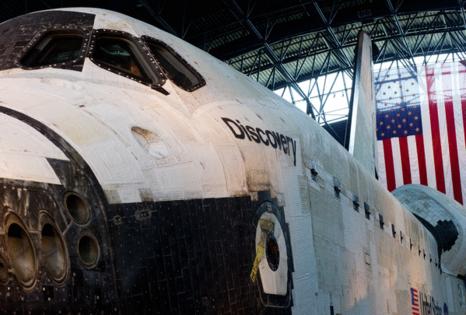Shuttle Discovery's Texas transfer launches cost concerns
Published in News & Features
WASHINGTON — The Smithsonian Institution is resisting an effort from Texas lawmakers to transport the space shuttle Discovery from a Virginia museum to Houston, home of Mission Control, in a battle framed by the cost.
Texas GOP Sens. John Cornyn and Ted Cruz included in the reconciliation law a provision that would authorize the relocation of the shuttle from its current display at the Smithsonian’s National Air and Space Museum Steven F. Udvar-Hazy Center in Chantilly, Virginia, to a site near Houston’s Johnson Space Center, which Cornyn described in a statement as “righting this egregious wrong.”
Entering service in 1984, Discovery was the third space shuttle orbiter to fly in space and became the most utilized one, spending a total of 365 days in space, according to the Smithsonian. After the shuttle was retired in 2011, it was transferred to the Smithsonian in April 2012 after a delivery flight over the nation’s capital.
The law provided $85 million for the move, at least $5 million of which would be used for transporting the shuttle.
“Houston has long stood at the heart of America’s human spaceflight program, and this legislation rightly honors that legacy,” Cruz said in a statement after the bill’s passage. “Bringing such a historic space vehicle to the region would underscore the city’s indispensable contributions to our space missions, highlight the strength of America’s commercial space partnerships, and inspire future generations of engineers, scientists, and pioneers who will carry our legacy of American leadership in space.”
But clashing cost estimates to relocate the shuttle have raised questions over whether the reconciliation law funding is enough.
According to a Congressional Research Service report published last week, the Smithsonian estimated that transport of the shuttle would cost about $50 million to $55 million, and that the costs to prepare the museum for moving the orbiter and to construct a permanent display facility elsewhere would be about $325 million — much greater than the $85 million provided.
A Smithsonian spokesperson added in a statement that the orbiter is a “fragile object” and must be handled according to standards and equipment NASA used to move it originally, which exceeds standard museum protocols.
“Removing Discovery from the Udvar-Hazy Center and transporting it to another location would be very complicated and expensive, and likely result in irreparable damage to the shuttle and its components,” the spokesperson said. “Given its age and condition, Discovery is at even greater risk today. The Smithsonian employs world-class preservation and conservation methods, and maintaining Discovery’s current conditions is critical to its long-term future.”
But the CRS report adds that a private company with experience in moving large vehicles offered a preliminary estimate of $8 million to transport it, a figure much more in line with the reconciliation law’s funding.
The report explained that cost estimates can vary widely based on what’s included, such as preparation, potential disassembly, support facilities or physical transportation. “Any of these costs might change as the details of the move are clarified,” it said, adding that Congress may request a cost analysis of the project.
Space Center Houston, where the Shuttle would likely go, issued a statement Friday saying it had not commissioned independent relocation estimates, but instead is focused on “planning a world-class home for Discovery.”
“This opportunity aligns naturally with our long-term plans,” said Keesha Bullock, chief communications and marketing officer at Space Center Houston.
Long fight
The Texas lawmakers have been fighting to return the shuttle to Houston since its retirement, arguing that its rightful home was Texas since mission control at NASA’s Johnson Space Center led all of the shuttle’s flights.
When four shuttles were retired from NASA around 2010, one of them was expected to go on display in Houston, according to the lawmakers. Lawmakers added language in the NASA Authorization Act of 2010 directing the space agency to give priority decision of display and ownership to “locations ... with a historical relationship to the launch, flight operations, or processing of the Space Shuttle orbiters or the retrieval of NASA-manned space vehicles, or significant contributions to human space flight.”
However, citing a 1967 agreement between NASA and the Smithsonian that directed “all historically important air and space artifacts developed by NASA will be transferred to the National Air and Space Museum,” Discovery was moved to Virginia.
“Collecting and preserving artifacts like Space Shuttle Orbiter Discovery is part of the National Air and Space Museum’s mission and core function as a research facility and the repository of the national air and space collection,” a Smithsonian spokesperson said in a statement. “The museum holds the most comprehensive collection of artifacts that document America’s successful efforts to lead the world in human exploration.”
The Texas lawmakers’ relocation wishes are still seeing resistance.
Cruz and Cornyn finally succeeded in including the provision and funding in the reconciliation law after retooling it to address two separate “Byrd rule” violations, and it then survived an attempt to strip it during the Senate’s “vote-a-rama” in the form of an amendment backed by Virginia Democratic Sens. Tim Kaine and Mark Warner.
More recently, House appropriators last week adopted an amendment from Rep. Joseph D. Morelle, D-N.Y., during the markup of its fiscal 2026 Interior-Environment funding bill that would bar any funds provided for the Smithsonian Institution to be used for the planned transfer. The amendment passed by voice vote, with Interior-Environment Appropriations Subcommittee Chairman Mike Simpson, R-Idaho, noting he supported it.
“It is unprecedented for Congress to order the removal of an object from the Smithsonian collections and send it somewhere else,” Morelle said. “I think this sets a very dangerous precedent, and let’s not forget Discovery is part of American history and future generations deserve to be able to see it in top condition here in the nation’s capital.”
But since it’s not clear that Smithsonian funds would be needed, Morelle’s amendment could be more symbolic in nature.
Since the vote on the reconciliation package, an advocacy group named KeepTheShuttle has been organizing opposition. Group founder Joe Stief, a health care private equity investor who is new to federal advocacy, was married in front of the shuttle. While he acknowledges his personal connection to Discovery, his group is attempting to highlight other concerns.
“I think why the move is a bad idea really comes down to three words at the end of it,” Stief said in an interview. “It’s the cost, it’s the logistics, and it’s the precedent.”
In addition to potential cost overruns, Stief said that moving the shuttle would be logistically difficult. During the space shuttle program, orbiters were moved by modified 747s that have since been retired. Disassembling the shuttle could cause permanent damage, and when the space shuttle Endeavour was moved in 2012, officials in Los Angeles had to cut down 400 trees and protect streets with steel plates to prevent damage to underground utilities.
Like Morelle, he also raised the concern of precedent.
“The Smithsonian is America’s national museum. It’s meant to showcase the nation’s collective heritage, and that applies not just to Air and Space, that applies to everything in the collection,” Stief said. “And if two senators can, frankly, pilfer a space shuttle for their home state by sneaking an amendment into a budget bill, well that really sets an alarming precedent where other elected officials, either party from any state, could do similar things in the future.”
©2025 CQ-Roll Call, Inc., All Rights Reserved. Visit cqrollcall.com. Distributed by Tribune Content Agency, LLC.







Comments